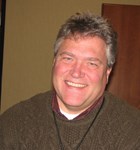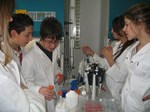The 2010 ITER Baseline configuration will be THE reference document for the construction phase of the project. Currently under finalization, it will be proposed for definitive adoption by the ITER Members at next June's sixth ITER Council.
But even as work continues to complete it, approximately 50 project change requests (PCRs) are in the pipeline for examination or implementation. These PCRs affect one, or potentially more than one, of the Baseline documents.
"Projects are never static," says Martin Dentan, Section Leader for Systems Engineering and Configuration Management at ITER. "Change requests will come up throughout the lifetime of the project ... that's unavoidable. We've established a process that allows us to reach agreement on a change with every party involved, and to inform all the others about modifications to systems covered by the ITER configuration."
Proposals for modification—whether pertaining to technical scope, cost, or schedule—are written up as PCRs and submitted to one of the two ITER Configuration Control Boards (CCBs). Each CCB has permanent members representing the senior management of all Offices and Departments at ITER, and the seven Domestic Agencies.
CCB1, chaired by the ITER Principal Deputy Director-General (PDDG) Norbert Holtkamp, examines changes having major impact on the project (level 0 or 1 changes). CCB2, chaired by the Deputy Director-General of the ITER Office for Central Integration & Engineering, Eisuke Tada, examines level 2 changes. Following examination by the Boards, PCRs are either accepted for study, endorsed for inclusion in the Baseline, or rejected. For level 0 changes—those with greatest impact—further approval by the ITER Council is required following endorsement by CCB1.
"The aim of the Configuration Control Boards is to decide if the proposed change is desirable, and to make sure that its impact on other systems and on transverse areas such as cost, schedule, risk or safety has been properly assessed and is acceptable," explains Martin. "Since 2005, we've had 240 PCRs. Each time, the initiator of the PCR must provide evidence that all repercussions have been thoroughly examined."
That's something that requires very careful documentation and study. Between the formulation of a PCR and its acceptance in the ITER configuration, depending on the duration of the study, wait time can vary from a few weeks to one or two years.
Krystyna Marcinkiewicz manages the process of PCR submittals to CCB1. "I often feel guilty when asking submitters to fill out the required forms. They're complicated!" she says. "Now we are progressively replacing them by data recorded in a database we have developed. This new tool should make the preparation and management of PCRs much easier. The procedure itself is complex, but for a project like ITER, changes cannot be decided without carefully assessing their value and their consequences, and they cannot be implemented in the ITER configuration without proper control."
"The PCR process at ITER allows changes to be formally introduced and approved into the project," sums up Martin. "The Baseline configuration should be thought of as a snapshot in time. Between one iteration of the Baseline configuration and the next—further down the road—configuration management is necessary to document and track all project changes."
Two appointments have been announced at the US ITER Project Office (USIPO): Wayne Reiersen has been named Magnet Systems Team Leader and Janet Bivens is the new Senior Project Controls Analyst.
Wayne, an employee of Princeton Plasma Physics Laboratory (PPPL), had been serving as Interim Manager for Magnet Systems following the retirement of John Miller. In that role, Wayne provided significant support during preparations for the recent Lehman Review. He joined the US ITER Project Chief Engineer's Group in 2007, after holding several engineering management positions at PPPL, including work with the National Compact Stellarator Experiment, KSTAR, and TPX projects. Wayne has more than 32 years of diversified experience in engineering analysis, systems engineering, and engineering management. He received a B.S. in mechanical engineering from Cornell University and a Master's degree in nuclear engineering from the University of Tennessee.
Janet, who succeeds Wayne Steffey (now USIPO Project Controls Manager), had served most recently as Finance Officer for US ITER. She joined the Oak Ridge National Laboratory staff in 2000 as a student worker and has taken on positions of increasing responsibility, including that of Finance Officer for the Spallation Neutron Source Accelerator Systems Division. Janet became a member of the US ITER team in 2006. She received a B.S. in accounting from the University of Tennessee and a Master's degree in project management from Western Carolina University. Janet is a Certified Project Management Professional.
The UK's innovative Mega Amp Spherical Tokamak (MAST) facility at Culham Centre for Fusion Energy will receive a £30 million upgrade to achieve near-fusion conditions in a compact device and ensure the successful completion of three tasks central to the progress of the international fusion R&D program. MAST is leading worldwide studies into the spherical tokamak, a compact alternative to the JET-ITER-style magnetic confinement fusion configuration. Spherical tokamak innovations promise to deliver more efficient energy production in fusion reactors. The Engineering and Physical Sciences Research Council—the main funding body for the UK fusion program—has now given approval for the upgrade project, with completion expected in 2015. This follows the recommendations of an independent review of the fusion program for Research Councils UK, published in February 2010, which endorsed MAST Upgrade as part of a long-term funding strategy for UK magnetic confinement fusion research.
Click here to read the Press Release...
Click here to view the MAST Upgrade video...
"CEA-Jeunes," which could translate as "CEA-Youth Day," was established in 1994 to provide junior high students with a two-day experience of daily life at a major research centre.
CEA-Cadarache, like all CEA centres throughout the country, participates in the event. On 25 and 26 March this year, 200 students from 20 neighbouring "colleges" (junior high schools) were welcomed onsite for various workshops on nuclear energy, safety and life sciences.
As part of the event, five 15-year-old students volunteered to produce a two-page newsletter, ITERnet, about the ITER project and work progress on the platform.
Youngsters participating in the "CEA-Jeunes" program are given an opportunity to discover the wide range of activities being conducted in a nuclear research centre, how these activities reflect society's needs and preoccupations and ... how exciting they can be.
After experiencing—however briefly and superficially—what a scientist's or an engineer's work is all about, perhaps some of the participating students will embrace scientific studies.
Enrollment in science programs that had been dramatically waning for the past two decades, now appears to be stabilized—experiences like "CEA-Jeunes" certainly contributed to this evolution.
|
A lot has happened at the International School Manosque (ISM)over the last year. To give an overview of these developments, and also to listen to the issues raised by parents, a meeting between Jean-Paul Clément, Head of the International School, and the ITER /ISM parents took place at the Château de Cadarache on 30 March.
The school now has 300 students, 160 of which (53 percent) are ITER children. By the end of the school year, another 25 students will have arrived. Both primary school and kindergarten have integrated the new school buildings, and at the start of the new school year (2010/2011) the remaining sections (Collège and Lycée) will also move into the new premises. The entire International School Manosque will be housed under one roof.
At the beginning of the new school year, a school transport service will also be launched from St Paul-lez-Durance via Cadarache to the International School to enable pupils that do not live in or near Manosque to join the school.
After an introductory speech by the ITER Director-General Kaname Ikeda, in which he summarized the major milestones of the development of the school and what remains to be done, Mr Clément elaborated on the status and future developments of the school.
Victor Udintsev, member of the ITER Staff Committee then presented a list of key issues that had been raised by the parents and asked the school's director for his feedback on each of these concerns. Most of the issues that were brought up evolved around teaching quality, buildings and safety concerns and organizational issues. Whereas many of these questions were answered by the school's director at the meeting, some others will be dealt with at the upcoming International School Steering Committee meeting.
The European Commission has re-launched its energy research website. Over 200 pages offer complete information on all funding opportunities in the field of energy and nuclear energy research at EU level. Its completely updated visual content, including videos, animations, interviews and clips, and a comprehensive publication search tool, together with a concise description of the policy framework will guide you fast and efficiently through the European panorama on energy research.
Click here for the new EU Research website ...
|










